#writing indians
Text
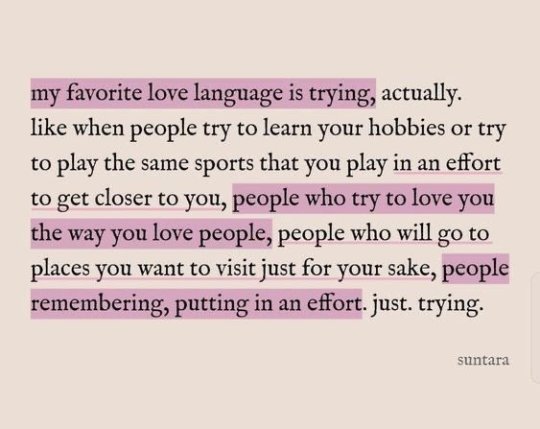
#desiblr#desi tumblr#desi academia#txt post#txt#dark academia#dark romanticism#writers on tumblr#light academia#light acamedia#indian dark academia#dark aesthetic#poets on tumblr#poetry#spilled ink#spilled writing#spilled words#spilled thoughts#writerblr#writer community#writers#ao3 writer#bookblr#manincaffeine
3K notes
·
View notes
Text
Fantasy Guide to Interiors



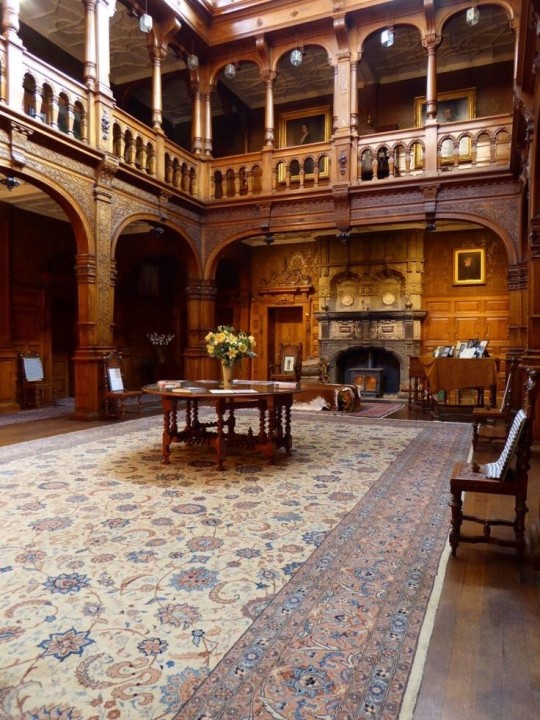
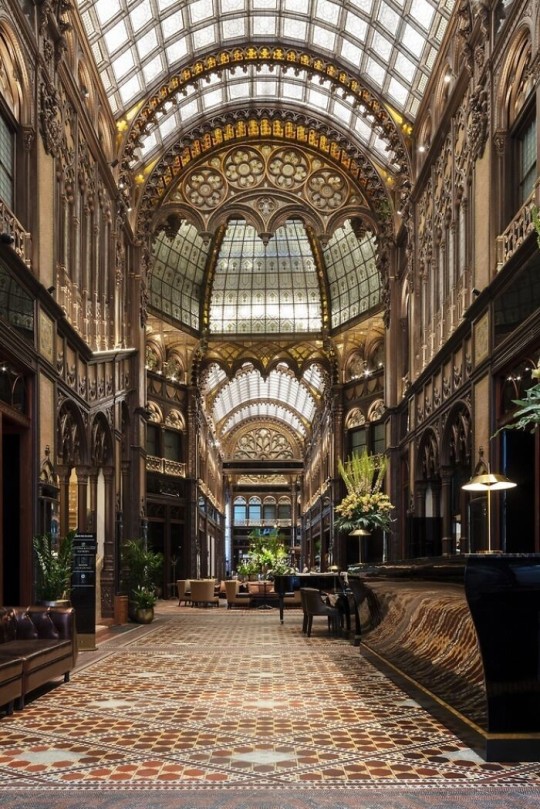
As a followup to the very popular post on architecture, I decided to add onto it by exploring the interior of each movement and the different design techniques and tastes of each era. This post at be helpful for historical fiction, fantasy or just a long read when you're bored.
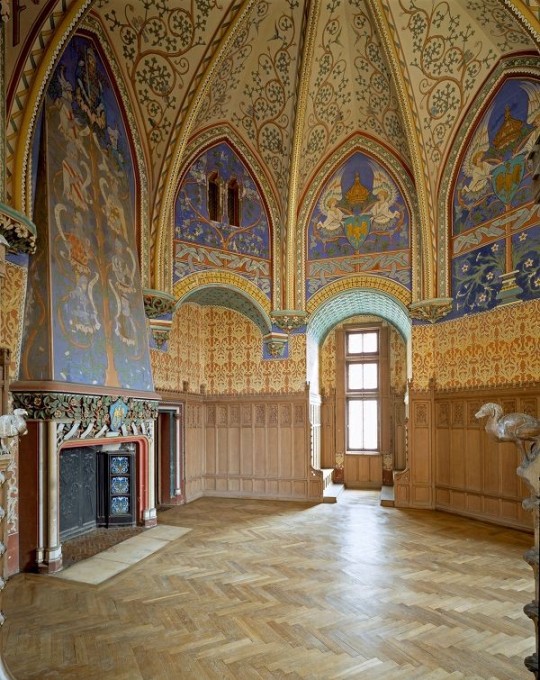


Interior Design Terms
Reeding and fluting: Fluting is a technique that consists a continuous pattern of concave grooves in a flat surface across a surface. Reeding is it's opposite.
Embossing: stamping, carving or moulding a symbol to make it stand out on a surface.
Paneling: Panels of carved wood or fabric a fixed to a wall in a continuous pattern.
Gilding: the use of gold to highlight features.
Glazed Tile: Ceramic or porcelain tiles coated with liquid coloured glass or enamel.
Column: A column is a pillar of stone or wood built to support a ceiling. We will see more of columns later on.
Bay Window: The Bay Window is a window projecting outward from a building.
Frescos: A design element of painting images upon wet plaster.
Mosaic: Mosaics are a design element that involves using pieces of coloured glass and fitted them together upon the floor or wall to form images.
Mouldings: ornate strips of carved wood along the top of a wall.
Wainscoting: paneling along the lower portion of a wall.
Chinoiserie: A European take on East Asian art. Usually seen in wallpaper.
Clerestory: A series of eye-level windows.
Sconces: A light fixture supported on a wall.
Niche: A sunken area within a wall.
Monochromatic: Focusing on a single colour within a scheme.
Ceiling rose: A moulding fashioned on the ceiling in the shape of a rose usually supporting a light fixture.
Baluster: the vertical bars of a railing.
Façade: front portion of a building
Lintel: Top of a door or window.
Portico: a covered structure over a door supported by columns
Eaves: the part of the roof overhanging from the building
Skirting: border around lower length of a wall
Ancient Greece
Houses were made of either sun-dried clay bricks or stone which were painted when they dried. Ground floors were decorated with coloured stones and tiles called Mosaics. Upper level floors were made from wood. Homes were furnished with tapestries and furniture, and in grand homes statues and grand altars would be found. Furniture was very skillfully crafted in Ancient Greece, much attention was paid to the carving and decoration of such things. Of course, Ancient Greece is ancient so I won't be going through all the movements but I will talk a little about columns.
Doric: Doric is the oldest of the orders and some argue it is the simplest. The columns of this style are set close together, without bases and carved with concave curves called flutes. The capitals (the top of the column) are plain often built with a curve at the base called an echinus and are topped by a square at the apex called an abacus. The entablature is marked by frieze of vertical channels/triglyphs. In between the channels would be detail of carved marble. The Parthenon in Athens is your best example of Doric architecture.
Ionic: The Ionic style was used for smaller buildings and the interiors. The columns had twin volutes, scroll-like designs on its capital. Between these scrolls, there was a carved curve known as an egg and in this style the entablature is much narrower and the frieze is thick with carvings. The example of Ionic Architecture is the Temple to Athena Nike at the Athens Acropolis.
Corinthian: The Corinthian style has some similarities with the Ionic order, the bases, entablature and columns almost the same but the capital is more ornate its base, column, and entablature, but its capital is far more ornate, commonly carved with depictions of acanthus leaves. The style was more slender than the others on this list, used less for bearing weight but more for decoration. Corinthian style can be found along the top levels of the Colosseum in Rome.
Tuscan: The Tuscan order shares much with the Doric order, but the columns are un-fluted and smooth. The entablature is far simpler, formed without triglyphs or guttae. The columns are capped with round capitals.
Composite: This style is mixed. It features the volutes of the Ionic order and the capitals of the Corinthian order. The volutes are larger in these columns and often more ornate. The column's capital is rather plain. for the capital, with no consistent differences to that above or below the capital.
Ancient Rome
Rome is well known for its outward architectural styles. However the Romans did know how to add that rizz to the interior. Ceilings were either vaulted or made from exploded beams that could be painted. The Romans were big into design. Moasics were a common interior sight, the use of little pieces of coloured glass or stone to create a larger image. Frescoes were used to add colour to the home, depicting mythical figures and beasts and also different textures such as stonework or brick. The Romans loved their furniture. Dining tables were low and the Romans ate on couches. Weaving was a popular pastime so there would be tapestries and wall hangings in the house. Rich households could even afford to import fine rugs from across the Empire. Glass was also a feature in Roman interior but windows were usually not paned as large panes were hard to make. Doors were usually treated with panels that were carved or in lain with bronze.
Ancient Egypt
Egypt was one of the first great civilisations, known for its immense and grand structures. Wealthy Egyptians had grand homes. The walls were painted or plastered usually with bright colours and hues. The Egyptians are cool because they mapped out their buildings in such a way to adhere to astrological movements meaning on special days if the calendar the temple or monuments were in the right place always. The columns of Egyptian where thicker, more bulbous and often had capitals shaped like bundles of papyrus reeds. Woven mats and tapestries were popular decor. Motifs from the river such as palms, papyrus and reeds were popular symbols used.
Ancient Africa
African Architecture is a very mixed bag and more structurally different and impressive than Hollywood would have you believe. Far beyond the common depictions of primitive buildings, the African nations were among the giants of their time in architecture, no style quite the same as the last but just as breathtaking.
Rwandan Architecture: The Rwandans commonly built of hardened clay with thatched roofs of dried grass or reeds. Mats of woven reeds carpeted the floors of royal abodes. These residences folded about a large public area known as a karubanda and were often so large that they became almost like a maze, connecting different chambers/huts of all kinds of uses be they residential or for other purposes.
Ashanti Architecture: The Ashanti style can be found in present day Ghana. The style incorporates walls of plaster formed of mud and designed with bright paint and buildings with a courtyard at the heart, not unlike another examples on this post. The Ashanti also formed their buildings of the favourite method of wattle and daub.
Nubian Architecture: Nubia, in modern day Ethiopia, was home to the Nubians who were one of the world's most impressive architects at the beginning of the architecture world and probably would be more talked about if it weren't for the Egyptians building monuments only up the road. The Nubians were famous for building the speos, tall tower-like spires carved of stone. The Nubians used a variety of materials and skills to build, for example wattle and daub and mudbrick. The Kingdom of Kush, the people who took over the Nubian Empire was a fan of Egyptian works even if they didn't like them very much. The Kushites began building pyramid-like structures such at the sight of Gebel Barkal
Japanese Interiors
Japenese interior design rests upon 7 principles. Kanso (簡素)- Simplicity, Fukinsei (不均整)- Asymmetry, Shizen (自然)- Natural, Shibumi (渋味) – Simple beauty, Yugen (幽玄)- subtle grace, Datsuzoku (脱俗) – freedom from habitual behaviour, Seijaku (静寂)- tranquillity.
Common features of Japanese Interior Design:
Shoji walls: these are the screens you think of when you think of the traditional Japanese homes. They are made of wooden frames, rice paper and used to partition
Tatami: Tatami mats are used within Japanese households to blanket the floors. They were made of rice straw and rush straw, laid down to cushion the floor.
Genkan: The Genkan was a sunken space between the front door and the rest of the house. This area is meant to separate the home from the outside and is where shoes are discarded before entering.
Japanese furniture: often lowest, close to the ground. These include tables and chairs but often tanked are replaced by zabuton, large cushions. Furniture is usually carved of wood in a minimalist design.
Nature: As both the Shinto and Buddhist beliefs are great influences upon architecture, there is a strong presence of nature with the architecture. Wood is used for this reason and natural light is prevalent with in the home. The orientation is meant to reflect the best view of the world.
Islamic World Interior
The Islamic world has one of the most beautiful and impressive interior design styles across the world. Colour and detail are absolute staples in the movement. Windows are usually not paned with glass but covered in ornate lattices known as jali. The jali give ventilation, light and privacy to the home. Islamic Interiors are ornate and colourful, using coloured ceramic tiles. The upper parts of walls and ceilings are usually flat decorated with arabesques (foliate ornamentation), while the lower wall areas were usually tiled. Features such as honeycombed ceilings, horseshoe arches, stalactite-fringed arches and stalactite vaults (Muqarnas) are prevalent among many famous Islamic buildings such as the Alhambra and the Blue Mosque.
Byzantine (330/395–1453 A. D)
The Byzantine Empire or Eastern Roman Empire was where eat met west, leading to a melting pot of different interior designs based on early Christian styles and Persian influences. Mosaics are probably what you think of when you think of the Byzantine Empire. Ivory was also a popular feature in the Interiors, with carved ivory or the use of it in inlay. The use of gold as a decorative feature usually by way of repoussé (decorating metals by hammering in the design from the backside of the metal). Fabrics from Persia, heavily embroidered and intricately woven along with silks from afar a field as China, would also be used to upholster furniture or be used as wall hangings. The Byzantines favoured natural light, usually from the use of copolas.
Indian Interiors
India is of course, the font of all intricate designs. India's history is sectioned into many eras but we will focus on a few to give you an idea of prevalent techniques and tastes.
The Gupta Empire (320 – 650 CE): The Gupta era was a time of stone carving. As impressive as the outside of these buildings are, the Interiors are just as amazing. Gupta era buildings featured many details such as ogee (circular or horseshoe arch), gavaksha/chandrashala (the motif centred these arches), ashlar masonry (built of squared stone blocks) with ceilings of plain, flat slabs of stone.
Delhi Sultanate (1206–1526): Another period of beautifully carved stone. The Delhi sultanate had influence from the Islamic world, with heavy uses of mosaics, brackets, intricate mouldings, columns and and hypostyle halls.
Mughal Empire (1526–1857): Stonework was also important on the Mughal Empire. Intricately carved stonework was seen in the pillars, low relief panels depicting nature images and jalis (marble screens). Stonework was also decorated in a stye known as pietra dura/parchin kari with inscriptions and geometric designs using colored stones to create images. Tilework was also popular during this period. Moasic tiles were cut and fitted together to create larger patters while cuerda seca tiles were coloured tiles outlined with black.
Chinese Interiors
Common features of Chinese Interiors
Use of Colours: Colour in Chinese Interior is usually vibrant and bold. Red and Black are are traditional colours, meant to bring luck, happiness, power, knowledge and stability to the household.
Latticework: Lattices are a staple in Chinese interiors most often seen on shutters, screens, doors of cabinets snf even traditional beds.
Lacquer: Multiple coats of lacquer are applied to furniture or cabinets (now walls) and then carved. The skill is called Diaoqi (雕漆).
Decorative Screens: Screens are used to partition off part of a room. They are usually of carved wood, pained with very intricate murals.
Shrines: Spaces were reserved on the home to honour ancestors, usually consisting of an altar where offerings could be made.
Of course, Chinese Interiors are not all the same through the different eras. While some details and techniques were interchangeable through different dynasties, usually a dynasty had a notable style or deviation. These aren't all the dynasties of course but a few interesting examples.
Song Dynasty (960–1279): The Song Dynasty is known for its stonework. Sculpture was an important part of Song Dynasty interior. It was in this period than brick and stone work became the most used material. The Song Dynasty was also known for its very intricate attention to detail, paintings, and used tiles.
Ming Dynasty(1368–1644): Ceilings were adorned with cloisons usually featuring yellow reed work. The floors would be of flagstones usually of deep tones, mostly black. The Ming Dynasty favoured richly coloured silk hangings, tapestries and furnishings. Furniture was usually carved of darker woods, arrayed in a certain way to bring peace to the dwelling.
Han Dynasty (206 BC-220 AD): Interior walls were plastered and painted to show important figures and scenes. Lacquer, though it was discovered earlier, came into greater prominence with better skill in this era.
Tang Dynasty (618–907) : The colour palette is restrained, reserved. But the Tang dynasty is not without it's beauty. Earthenware reached it's peak in this era, many homes would display fine examples as well. The Tang dynasty is famous for its upturned eaves, the ceilings supported by timber columns mounted with metal or stone bases. Glazed tiles were popular in this era, either a fixed to the roof or decorating a screen wall.
Romanesque (6th -11th century/12th)
Romanesque Architecture is a span between the end of Roman Empire to the Gothic style. Taking inspiration from the Roman and Byzantine Empires, the Romanesque period incorporates many of the styles. The most common details are carved floral and foliage symbols with the stonework of the Romanesque buildings. Cable mouldings or twisted rope-like carvings would have framed doorways. As per the name, Romansque Interiors relied heavily on its love and admiration for Rome. The Romanesque style uses geometric shapes as statements using curves, circles snf arches. The colours would be clean and warm, focusing on minimal ornamentation.
Gothic Architecture (12th Century - 16th Century)
The Gothic style is what you think of when you think of old European cathedrals and probably one of the beautiful of the styles on this list and one of most recognisable. The Gothic style is a dramatic, opposing sight and one of the easiest to describe. Decoration in this era became more ornate, stonework began to sport carving and modelling in a way it did not before. The ceilings moved away from barreled vaults to quadripartite and sexpartite vaulting. Columns slimmed as other supportive structures were invented. Intricate stained glass windows began their popularity here. In Gothic structures, everything is very symmetrical and even.
Mediaeval (500 AD to 1500)
Interiors of mediaeval homes are not quite as drab as Hollywood likes to make out. Building materials may be hidden by plaster in rich homes, sometimes even painted. Floors were either dirt strewn with rushes or flagstones in larger homes. Stonework was popular, especially around fireplaces. Grand homes would be decorated with intricate woodwork, carved heraldic beasts and wall hangings of fine fabrics.
Renaissance (late 1300s-1600s)
The Renaissance was a period of great artistry and splendor. The revival of old styles injected symmetry and colour into the homes. Frescoes were back. Painted mouldings adorned the ceilings and walls. Furniture became more ornate, fixed with luxurious upholstery and fine carvings. Caryatids (pillars in the shape of women), grotesques, Roman and Greek images were used to spruce up the place. Floors began to become more intricate, with coloured stone and marble. Modelled stucco, sgraffiti arabesques (made by cutting lines through a layer of plaster or stucco to reveal an underlayer), and fine wall painting were used in brilliant combinations in the early part of the 16th century.
Tudor Interior (1485-1603)
The Tudor period is a starkly unique style within England and very recognisable. Windows were fixed with lattice work, usually casement. Stained glass was also in in this period, usually depicting figures and heraldic beasts. Rooms would be panelled with wood or plastered. Walls would be adorned with tapestries or embroidered hangings. Windows and furniture would be furnished with fine fabrics such as brocade. Floors would typically be of wood, sometimes strewn with rush matting mixed with fresh herbs and flowers to freshen the room.
Baroque (1600 to 1750)
The Baroque period was a time for splendor and for splashing the cash. The interior of a baroque room was usually intricate, usually of a light palette, featuring a very high ceiling heavy with detail. Furniture would choke the room, ornately carved and stitched with very high quality fabrics. The rooms would be full of art not limited to just paintings but also sculptures of marble or bronze, large intricate mirrors, moldings along the walls which may be heavily gilded, chandeliers and detailed paneling.
Victorian (1837-1901)
We think of the interiors of Victorian homes as dowdy and dark but that isn't true. The Victorians favoured tapestries, intricate rugs, decorated wallpaper, exquisitely furniture, and surprisingly, bright colour. Dyes were more widely available to people of all stations and the Victorians did not want for colour. Patterns and details were usually nature inspired, usually floral or vines. Walls could also be painted to mimic a building material such as wood or marble and most likely painted in rich tones. The Victorians were suckers for furniture, preferring them grandly carved with fine fabric usually embroidered or buttoned. And they did not believe in minimalism. If you could fit another piece of furniture in a room, it was going in there. Floors were almost eclusively wood laid with the previously mentioned rugs. But the Victorians did enjoy tiled floors but restricted them to entrances. The Victorians were quite in touch with their green thumbs so expect a lot of flowers and greenery inside. with various elaborately decorated patterned rugs. And remember, the Victorians loved to display as much wealth as they could. Every shelf, cabinet, case and ledge would be chocked full of ornaments and antiques.
Edwardian/The Gilded Age/Belle Epoque (1880s-1914)
This period (I've lumped them together for simplicity) began to move away from the deep tones and ornate patterns of the Victorian period. Colour became more neutral. Nature still had a place in design. Stained glass began to become popular, especially on lampshades and light fixtures. Embossing started to gain popularity and tile work began to expand from the entrance halls to other parts of the house. Furniture began to move away from dark wood, some families favouring breathable woods like wicker. The rooms would be less cluttered.
Art Deco (1920s-1930s)
The 1920s was a time of buzz and change. Gone were the refined tastes of the pre-war era and now the wow factor was in. Walls were smoother, buildings were sharper and more jagged, doorways and windows were decorated with reeding and fluting. Pastels were in, as was the heavy use of black and white, along with gold. Mirrors and glass were in, injecting light into rooms. Gold, silver, steel and chrome were used in furnishings and decor. Geometric shapes were a favourite design choice. Again, high quality and bold fabrics were used such as animal skins or colourful velvet. It was all a rejection of the Art Noveau movement, away from nature focusing on the man made.
Modernism (1930 - 1965)
Modernism came after the Art Deco movement. Fuss and feathers were out the door and now, practicality was in. Materials used are shown as they are, wood is not painted, metal is not coated. Bright colours were acceptable but neutral palettes were favoured. Interiors were open and favoured large windows. Furniture was practical, for use rather than the ornamentation, featuring plain details of any and geometric shapes. Away from Art Deco, everything is straight, linear and streamlined.
#This took forever#I'm very tired#But enjoy#I covered as much as I could find#Fantasy Guide to interiors#interior design#Architecture#writings#writing resources#Writing reference#Writing advice#Writer's research#writing research#Writer's rescources#Writing help#Mediaeval#Renaissance#Chinese Interiors#Japanese Interiors#Indian interiors#writing#writeblr#writing reference#writing advice#writer#spilled words#writers
3K notes
·
View notes
Text
I think the best thing that our generation has normalised is having "online friends" . The bond created with these people is not based on their looks or their status but on the basis of their likes, their personalities, their favourite fandoms and their interests. You might have never shook hands or hugged them but still you are more comfortable telling them about your stupid mistakes and stupid jokes. The best thing about these friends is you don't have to meet them regularly to keep your friendship alive. And it's also the worst part not getting to meet them regularly or even once a week or once a month. From meeting them in the comment section of a meme to listening to their rants to updating them about our lives, online friends become our forever friends. It's a different kind of friendship but it's the cutest no pressure of any sort just two people sharing bits and pieces of their lives with each other and supporting each other.
#spilled truth#spilled thoughts#spilled ink#spilled journal#spilled words#spilled poetry#spilled writing#journalsofanaesthete#dishaa ke thoughts#desiblr#desi tumblr#writers and poets#gen z stuff#gen z things#gen z life#poets cafe#writers and readers#writers of tumblr#poets of tumblr#indian tumblr#artists on tumblr
592 notes
·
View notes
Text
Just incase you're having a bad day, I want you to know that in some universe Fleamont Potter is probably throwing it back Desi drunk dad style at a jegulus wedding
#fleamont potter#desi james potter#regulus black#jegulus#james potter#you haven't left lived if you haven't seen your drunk indian uncle trying to screw on hypothetical lightbulbs#wolfstar#desi dads#also effie joining him and them having one of those moments by#oh shit#i have to write a ff now#*sigh*
913 notes
·
View notes
Text
Just try looking for a positive story on China any day of the week in any of the leading global media outlets. Apart from reports in January about the Lunar New Year, there will hardly be any, and these too are likely to have a negative spin. It would appear there is a confidential memo circulating within Western media groups that guides reporters and editors to ensure there cannot be any positive news arising from a country with 1.3 billion people.
Typically, the negative stories adhere to three core ideas, which inform the unspoken guidelines within these press rooms when it comes to reporting on China.
First is the belief that China is a threat to the world and that this belief must be relentlessly reinforced at every available opportunity. How and why China is a threat is never explored; such is the deep-rooted and almost religious nature of the belief. Sound arguments do not matter. The basic tenets of good journalism are ignored when it comes to a China story. There is no need to explain or give evidence of why China is a global threat.
Left ignored is the plentiful evidence that shows China is not a global threat – even if one can point to mistakes and overreach in certain areas. China has not invaded any country in decades, or imposed sanctions that have devasted the lives of millions in poor countries, unlike the West, led by the United States.
Second is that China must be linked to every possible global event that affects the West. This provides an opportunity for the West to bash China while simultaneously burnishing its own credentials as the supposed arbiters of what is right and wrong in international relations. From the pandemic to the Russia-Ukraine war to carbon emissions; from rising sea levels to the scramble for rare earths; from the building of infrastructure in Africa to the production of vaccines – there must be an angle to demonize the country and instill fear in Western nations (and beyond).
Indeed, media outlets are reverting to the “yellow peril” of the late 1800s. There is no subtle and nuanced approach to instilling fear like this. It is full-on and very often blatantly racist – but it is now acceptable for one to be racist about the Chinese in Western media, despite the fact that Black-White relations are very carefully described.
The third part of this phenomenon, which is surprisingly not challenged by liberal readers of mainstream media, is the sentiment that everything must be done – even illegal and unfair methods – to arrest the rise of China. Never mind the rights of hundreds of millions of Chinese to have a better life after a century of poverty and deprivation.
#written by an indian-malaysian no less#i'm surprised as usually the people (regardless of ethnicity) who write for such publications#and who write this well and soundly#do so for NATO-friendly purposes. hopefully the tide will shift further soon
704 notes
·
View notes
Text
Date Ideas: Desi Edition
I'm in my TS Lover Era and I need some Pune date ideas so uh.. enjoy my thinking process ig
A proper date: dinner and drinks. Proper manners and polite conversation over good food and good beverages/drinks. You and your date pretend to be very serious adults with very serious jobs, and when you walk out of the restaurant you share a secret laugh as if you've pulled the greatest prank ever.
Chaha date. Standing on the side of a road under the insufficient cover of the chai stall with your fingers gripping the edge of plastic cups or mud tumblers, taking a deep sniff and closing your eyes at the smell of veldoda that wafts up. Looking up and catching their gaze already fixed on you, and looking back down, feeling the heat spread over your cheeks. You attribute it to the chaha's steam, but you know that's a lie. When you look back up, they're wating for you. They wink, and you nearly drop your cup, making them stifle a giggle.
Kulfi date. It's a crowded lane and you cram into the little hole in the wall kulfi parlour that's been there since your parents were children, excited smiles on both your faces. You order laal peru and request them to sprinkle chilli powder on top. Your partner gives you a dramatic scandalized look that has you cracking up and orders a sitafal kulfi without the chilli, please and thank you. With a lot of whining and teasing and mischievous smiles, you finally get them to taste your kulfi, and it ends with them ordering it for themself. You lean back in your chair and grin smugly even as they roll their eyes.
Book thrifting. Hands held, you walk into your usual book shop, a smile lighting up your face at the familiar smell of mogra and yellowing pages that hangs in the little room. It's a tiny shop in the basement of a shady old plaza, but it always has the best second hand books. The idea is to buy a book you think the other will enjoy, and then discuss them when you are done reading them. You pick up Ruined by Paula Morris, because you remember the three M's that your date swears by: Magic, Murder and Mystery. This is a perfect blend of all three, and you rather think they'll enjoy it. When you meet them at the counter, they have Nashtaneer by Rabindranath Thakur in their hands. You both grin at each other.
Juna Bazaar is as crowded as always. You giggle as they grip your wrist and drag you from shop to shop, rambling about their lecture in college. The sonchafa that you had tucked behind their ear is still there, and it makes something warm settle in your heart. You keep your mind on the mission though: buy three of the most interesting things you see, and then explain why you think it is interesting. They gasp and snap up a beautiful crystal vial like a magpie. It turns out to be kajal, made the traditional way. "You have to!" they insist, "it'll look so good with your pretty eyes!" You turn red and accept the little wand, dragging it between your eyelids. When you're done, your partner stares at you with their lips parted. Just as you're about to wave in front of their eyes and ask if they're okay, they lean forward and steal a lightning-fast kiss. "Too darn pretty for your own good, you are."
Camp area date! You two take a whole day to just stroll through Camp, pulling each other into random shops and cafés, looking at everything and eating from restaurants and roadside stalls alike. Your partner drags you deep into a sketchy looking plaza, and you find a clothing shop that sells the most random fashion items. You go to an ittr and perfume store. You visit Pasteur Ice Cream, Cafe Peter, the chaat stalls near Clover Centre and the barbeque corn stalls a little ways from Kumar Plaza. At the end of the day, you go home and show each other all your purchases; they bought you a bejewelled purse that goes with that one pair of your heels and you squeal over it, you bought them a chandan attar because you remember them mentioning it being their favourite smell and they immediately rub it over their wrists with a bright smile.
The two of you are tucked into a little corner of the garden. Sitting on an old bedsheet with several lunchboxes filled with bhel, samosa, kaju katli, shrikhand, slices of mango and watermelon and a bunch of green grapes. Your phone plays a familiar tune— Ishq Wala Love, and you're mouthing the lyrics in the most dramatic style that you can, revelling in the laughter of your partner. There is a mogra cha gajra braided into your hair and three roses tucked behind their ear; your little gifts to each other. Their eyes gleam bright with mirth, lips curved upward into a wide grin, and you can't help but lean forward and press a soft kiss to their lips. This picnic date is the best idea you've had in a while, you think, and the late spring flowers in bloom are the perfect addition.
.
Tag list: @mad-who-ra @yehsahihai @natures-marvel @musaafir-hun-yaaron @hum-suffer @h0bg0blin-meat @orgasming-caterpillar @wyvrens @kanha-sakhi
#amrut writes#amrut rambles#desiblr#desi tumblr#desi aesthetic#desi academia#indian aesthetic#indian academia#desi tag#romance#date ideas#desi date ideas#maharashtrian aesthetic#pune aesthetic#romantic#romantic aesthetic
343 notes
·
View notes
Text
"You look... woah"
For my fellow Bakusimps who wear dresses once in a blue moon, leaving necks cracked and jaws slacked.

You usually don't wear dresses and Bakugou knows that. He knows how dresses make you uncomfortable in one way or another; whether it be too stuffy, too frilly, too restrictive, too revealing, too non-revealing, too party-esque or too granny-style.
He knows if you had to pick between dresses and jeans, you'd go for the latter.
So imagine his surprise when he sees you wearing a dress.
Not only are you wearing a dress, you look like an absolute goddess in it.
You chose a simpler dress, showing off and highlighting your features in the best ways possible. The colour making your skin glow, the seams perfectly hugging your curves and edges, the longer part of the dress trailing behind you as you walk making it seem as if you're elegantly gliding across the room with the poise one would expect of a forest nymph or a princess.
You look ethereal and wide red irises follow your movements as you flit across the room, making sure everything's ready before leaving for your date with him.
You let out a sigh as you stand in the middle of your living room with your hands on your hips, your beautiful hair blowing slightly at the wind seeping in through the open window of the balcony.
"Okay, I think we're all ready to go!"
As you turn, taking one last sweep at everything, a pair of callous hands slide onto your waist that looks so pretty in that dress and you're spun around by your hunk of a boyfriend whose pupils are blown wide as he drinks in your form.
You laugh at his expression.
"What?"
"Nothing, princess, just... you look... woah"
You chuckle as you look up into his pretty eyes.
"I look 'woah'?"
He nods with a smirk.
"You look 'woah'..."
You laugh again as you plant a kiss on his nose.
"Shall we get moving, my 'woah' boyfriend?"
He returns your grin with one of his own as his hand slides into yours, leading you out the door.
"Yeah, let's go, princess. Gonna make everyone at that restaurant drool down their chins."

#my thoughts during classes because I wore a dress today lols#you know that feeling when you wanna see a specific scene written by someone#and then you remember you can write it yourself#bakugou x reader#bakugou katsuki#mha bakugou#bakugou x indian!reader#katsuki bakugo x reader
362 notes
·
View notes
Text
I'm not listening to a white person on what's racist or insensitive to brown people. read orientalism by edward said before talking to me or my son ever again
#“the take away was literally not a writing exercise” 1. it was 2#2. cant you white bitches do that on a different post#3. telling indians what is and isnt dismissive of what they go through is hmm. what is it called#4. fuck your saviour complex#5. you guys ARE incredibly dismissive of the global south. our lives are just fiction no what you bitches “warn” about is already happening#wanna talk about how american overconsumption is contributing to the climate crisis? or are you too pussy for that#sorry i dont want my post about how i dont want my people to die in heat strokes to be hijacked. be serious for once in your lives#“sci fi writers have been warning about this” cool! wonder where they got that from#plagiarising gayatri spivak cause i hate her. can the subaltern speak or is that too much for your cracker sensibilities
196 notes
·
View notes
Text
Indigenous Storytelling
A lot of the stuff I've posted so far is pretty white western-centric views of telling stories. The whole article is very informative! An excerpt:
"Many of the main characters in Plains Indian mythology never end. Not only are they immortal and indestructible—where they may be killed in one story and are right back at it in another—they also age with the listener. Coyote stories for children have childlike morals; for teens Coyote is a much rougher character; and, for elders only, grandpa Coyote is smart, and his stories are deep and filled with complicated plots and plans."
#american indian#indigenous#native american#stories#myths#storytelling#story structure#story#writing#on writing#rightwriter#writing advice#nanowrimo 2023#preptober#nanowrimo#writer#writing tips
546 notes
·
View notes
Text
Ghar -घर -گھر
"Ghar" is such a beautiful term. Like how randomly we say "Ghar ja raha hoon", "Ghar par hoon", "yai Ghar hai mera." So beautiful and so calming. Just a piece of land, doesn't matter how fancy or simple, but we're all emotionally attached to it.🤍
#home#ghar#desi tumblr#desi people#desi#desi indian#desi tag#just desi things#urdu#urdu lines#urdu adab#urdu poetry#urdu stuff#urdu language#urdu words#urdu literature#lit#dark academia#writerblr#poetblr#aesthetic post#aesthetics#relateable#writings#artist on tumblr#writer on tumblr#light academia#instagram#writers and poets#poetscommunity
203 notes
·
View notes
Text
तुम्हारी आंखों के सिवा दुनिया में रखा क्या है.... 💗
आंखें ऐसी
जो पहले कभी ना देखी वैसी
डूब रही थी मैं उनकी
महासागर सी आंखों में
और सहारा चाहिए भी था
तो उन्ही की बाहों का..... ~ K.Y 💗

PS - this is me
#desi tumblr#desiblr#desi tag#desi teen#desi academia#desi people#desi shit posting#relatable af#relatable content#desi aesthetic#spilled truth#spilled ink#spilled thoughts#spilled words#spilled poetry#spilled writing#poetry community#poetry on tumblr#hindiblr#hindi post#hindi shayari#hindi poetry#indian tumblr#brown eyes#eyes
88 notes
·
View notes
Text
I really love the idea of romanticising life but not in a way perceived on social media where it all feels like a compulsion of looking cute, clicking cute pictures and loving things. Honestly romanticising doesn't mean any of that, it's not about loving things forcefully but about appreciating things. It's about finding beauty in the chaos and celebrating it instead of waiting for a perfect moment or a perfect place. The idea of romanticising life is more about finding moments of peace in your daily life instead of wishing to escape your life. It could be you just drinking a cup of coffee on a morning but without any anxiety in your gut, it could be the colourful sky at the time of sunset, it could be you journaling in your cute diary, it could be the whispers of gentle breeze, it could be a mere look at the sky. Romanticism saves people by actually filling people up with so much of gratitude for everything and everyone.

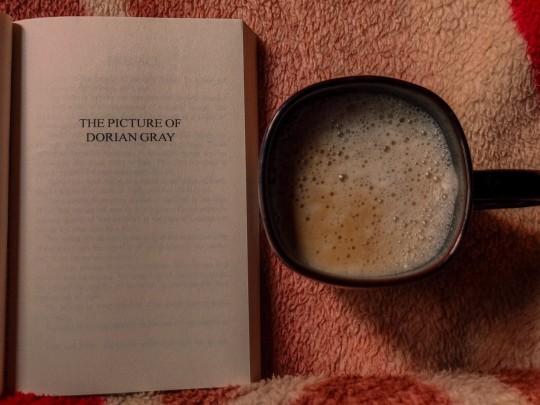


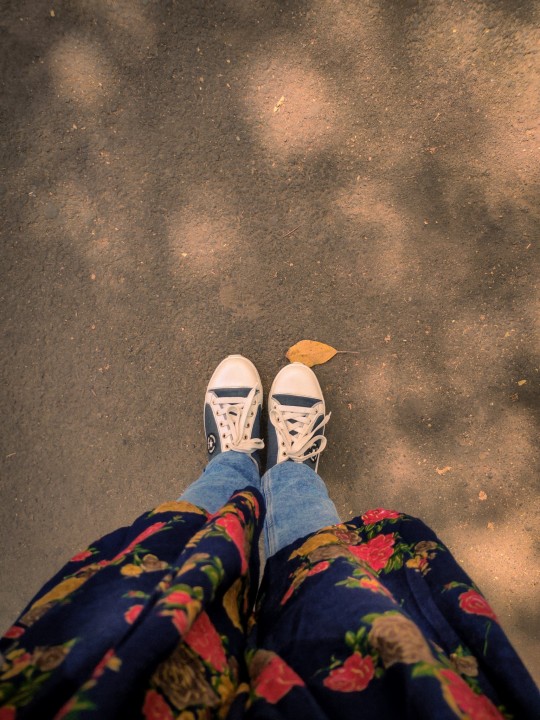
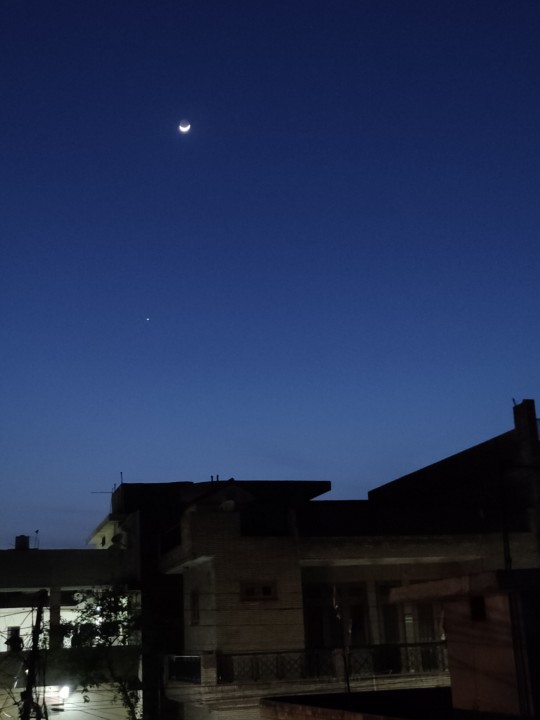

#journalsofanaesthete#dishaa's gallery#spilled journal#dishaa writes#aesthetic pictures#desi aesthetic#spilled truth#spilled thoughts#desiblr#desi tumblr#spilled words#writers and poets#romantic#romanticism#indian tumblr#dead poets society#writers and readers#poets on tumblr#poets cafe#writers of tumblr#artists on tumblr#desi#indian aesthetic#spilled ink#my words#spilled writing
409 notes
·
View notes
Text
Kuch soch kar hi milaya hoga uss rabb ne warna ittefaq kabse itne sundar hone lage .
-unknown
#txt#txt post#desi shit posting#desiblr#desi love#desi academia#desi stuff#text post#spilled words#spilled writing#dark acamedia#indian tumblr#desi tales#desi tag
147 notes
·
View notes
Text
i've seen iceman's complicated relationship to religion. i've seen ridden with southern bible bumping trauma hangman seresin. what about bradley bradshaw’s guilt- and grief-ridden catholicism? hm?
some of his only memories of his father are at midnight mass and singing carols on christmas, and not the fun ones, but the ones that shined a light on the lord and filled his words with devotion. even back then, when baby bradley had no idea what 'worship' was, his daddy did it and it made him feel so happy and so warm inside.
then im sorry and it was a training accident and an american flag folded into a pristine triangle. after that his momma couldn't stand going into church. they stood outside and listened to the sermons from the road and visited daddy's grave with flowers and prayers and i-miss-yous but bradley eventually forgot where their regular pew was and what the colour their pastor's hair was and what the wine (grape juice) tasted like. but he wore the cross. he always wore the cross.
and after momma died he stopped going all together. maverick wasn't religious. bradley told himself the reason he missed it was that he missed visiting the house of the lord, but really it was because maverick had other connections to nick and carole bradshaw, but bradley only had the church and now he doesn't even have that. sure, he's fine, but his dad’s cross hangs low on his chest like a brand because ever since dad died he's never felt the same devotion. now, his prayers aren't for god or christ, they’re for his momma and his daddy and he lies to himself that they aren't. and blasphemy is a cardinal sin.
then he looses maverick too. he floats around for years and forgets how to say his hail marys.
he re-applies for the academy and thanks the lord for the first time since he was a child that he got in. he follows in his father's footsteps and find a new church. he goes every sunday. he says grace. he does everything a proper christian should. honour thy father is written into every action he takes.
because his god is still his father. his holy spirit is still his mother. his christ is still maverick. he’s still sure that his prayers never reach their lord and saviour. and blasphemy is a cardinal sin.
#it physically pained me (english-indian) to write mom i cant lie#cw religion#bradley rooster bradshaw#mhm love me some religious trauma#nick goose bradshaw#carole bradshaw#pete maverick mitchell#top gun 1986#top gun#top gun maverick
119 notes
·
View notes
Text
#LongPost: A Few Hyper-Specific Things About India for India-Based Stories and Art
No this isn't a cry for more Indian-rep in Spider-Verse stories. (It is.)
Anyway. I recently went to India, and after returning to my hometown in Tamil Nadu, I reintegrated a whole slew of memories and collated new facts.. And considering I've been wanting to do one of these for quite some time (and because I need a new variety of Pavitr Prabhakar content), I thought it'd be cool if I shared some of my experiences and ideas with you.
It's best to take this with caution, though: the only places I've been to are Tiruchirappalli, Madurai, and a few towns located close to the Eastern Ghats, so my knowledge is heavily South India-based. I know for a fact that there are various similarities and differences between other geo-cultural areas of India, which is I why I've linked the other cool India Resources here as well.
In Which I Ramble About Pavitr's Character Design and the Indian Cultural Stuff Related to It by @chaos-and-sparkles (+ my addition + @neptune432's addition)
A culture post for the girlie pops (and non-girlie pops) looking to write Pavitr Prabhakar accurately by @summer-blues-stuff (+ my addition + @fandomsfeminismandme addition)
Also a timely reminder of @writingwithcolor's wonderful resources on writing about South Asian characters respectfully and sincerely
Now, for the things I've noticed in South India..
ANIMALS
There are a lot of street dogs. Like... a lot of them. And honestly it's so hard not to go up to one and give them a snack or two. The most notable dog breed is the Indian pariah and they can be found all over India. Mixed dog breeds are also common and results in a variety of features like differences in build and coat colours.


There are also other types of animals are pretty common to see alongside the roads.
Cattle are seen a lot (cows and bulls are easy to distinguish; cows (left) have udders and a small hump on their back, while bulls (right) are generally stockier and have a super-defined hump on their back). I'm pretty sure the specific cow breed is the sahiwal cow. They are either herded into paddocks for grazing or can be found wandering city streets on their own.

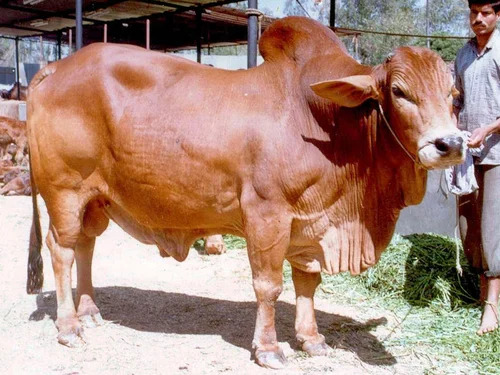
Goats are often herded by farmers into large masses of wool and horns and are guided to paddocks to graze. Sometimes, like cattle, they'll be found wandering city streets on their own.
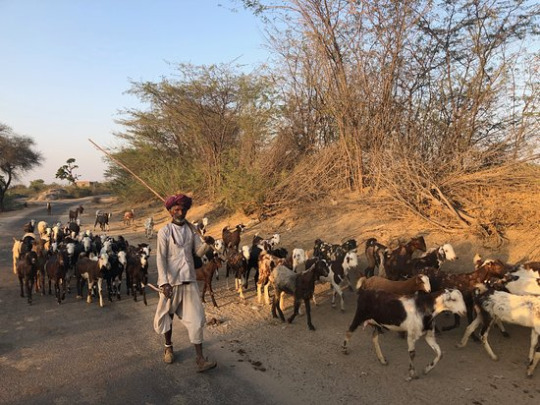
Chickens are usually kept close to stalls and homes. These chickens are not plump and fluffy like most Western chickens, but are quite skinny. Mottled feather colours are usually a result of mixed chicken breeds. In Tamil Nadu, the most common chicken breed is the asil chicken.
Various birds are often seen flying around traffic if they’re not disappearing into the sky, the most common being crows, pigeons and mynahs. (The chart below on the right is not an inexhaustive list of birds; you best search them up yourself.)
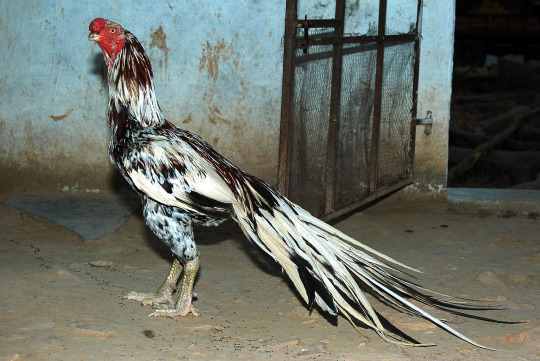

TRANSPORT
There is obviously a huge amount of trucks and lorries and buses. They all have beautiful designs or crazy LEDs or large detailed fluorescent / iridescent stickers that are impossible to ignore, whether it be at high noon or midnight.


Expanding on that, the most common method of transport are motorcyclse or scooties, cars, and autos.
Also, as expected: traffic is insane. It’s horrible. It’s exhilarating. Western honking is akin to swearing, but here? Honk whenever you want. Honk if you’re happy or if you’re sad. You get a million dollars if you honk. You need to honk. It’s more important than breathing
Similarly, road rules don’t exist. Well, they do, and the Indian government does everything it can to make sure people do follow the rules, but based on the aforementioned honking, most people don't. Everyone just drives. Most bikers and motorcyclists don’t wear helmets. Only a few people wear seatbelts. Cars and motorcycles drive on the wrong side of the road and right into oncoming traffic. The chance of someone dying is 99% but it’s countered by desi stubbornness.

ENVIRONMENT & INFRASTRUCTURE
Houses and buildings are painted different colours!!! Pastel pinks and purples and deep teal hues, either plain colours or decorated with elaborate murals. This also applies to interiors. I reckon it was surprising to a lot of people when they were confronted with Mumbattan's vibrant colours, but honestly: coloured buildings slap, and it's based on the real thing. They are a sight to behold. Couple that with the architecture and oh boy- you've got such a beautiful environment.






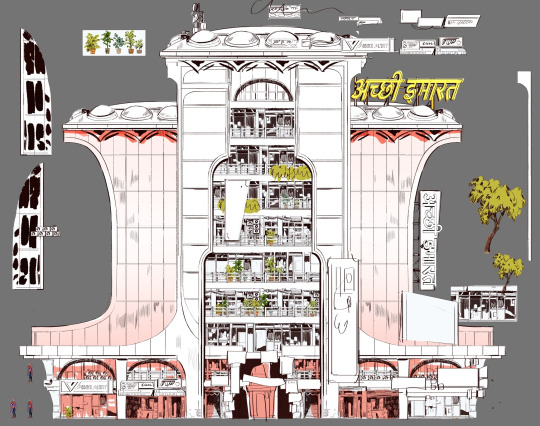
From @jettpack's concept art for Mumbattan buildings

jettpack's concept art of the Mumbattan collider
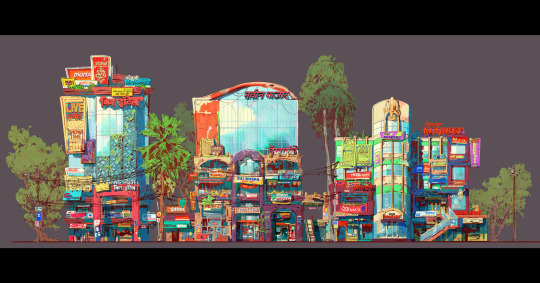
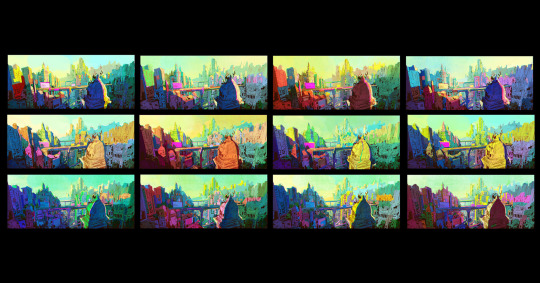
From @chenfelicia's concept and colour keys of Mumbattan
Don't be shy to really immerse in crazy descriptors - that's how you capture the liveliness of cities like Madurai and Mumbai and ultimately, their physical manifestations like Mumbattan.
Funny enough, movie posters and political banners and flyers are EVERYWHERE. They’re huge and take up entire billboards, or congregate along walls so it becomes practically a collage. It's impossible to ignore the image of "Makkal Selvan" Vijay Sethupathi about to beat some poor loser into a pulp with a stick, or the political parties roasting each other on paper with impressive photoshopped graphics.
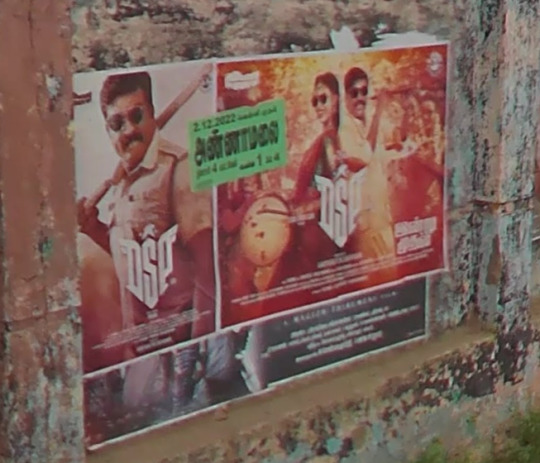

To tie in to the point about transport: there are hundreds of coffee stalls and snack shops and one-of-a-kind food stands. You can’t go 200 metres without running into one, either on the highway or in the city. I remember having jaggery coffee on my first night in India, and guys- it tasted so fucking good. I only wish I can transfer the taste to you. Absolutely splendid.
The climate in India is generally very humid and warm, but that doesn't mean we don't get cooler days; it is obviously cooler on winter nights. Also I've heard from many conflicting sources on India's seasonal weather (probably due to India's geograpghy), so you will have to talk to someone who is from India to really confirm. I've somewhat boiled it down to five seasons:
Summer - May-Jun; very hot (35-45ºC/95-113ºF), characterised by shrinking water bodies and droughts if there aren't any rainfalls; this time is good for plant growth/harvest if you've successfully managed water supplies
Monsoon - Jul-Aug; (34ºC/93ºF) very variable in terms of timing, characterised by torrential rains and floodings; the raining itself probably lodges somewhere in Jun-Sept but the aftereffects are felt long after the rains have stopped
Autumn - Sept-Nov; cooler but humid (25-35ºC/77-95ºF), and generally much drier since it transitions from autumn to winter
Winter - Dec-Feb; much colder, but the extent is dependent on geographic regions (20-25ºC/68-77ºF)
Spring - Mar-Apr; humid (33ºC/91ºF), sudden downpours, only occasionally do you get pleasant weather in this time
PEOPLE AND CULTURE
For some reason, there are still loud speakers blaring out music across the roads and as far as a few city blocks. I honestly thought that that had died out by the time my parents had graduated university, but it still seems like people like hearing music played at 120 decibels.
This is a complicated issue but people are not piss poor. Yes, India is a developing country, and yes there are slums and there are homeless and there are those who are stuck in a horrific sociocultural cycle, but people are rapidly getting into high-paying jobs at much higher rates than before. Overall, India is getting better; do us a favour and not have us be represented by the same poor struggle-riddled Indian stories that Hollywood and Western media is are fond of portraying.
@neptune432: One thing I think it's important to acknowledge though is how your experience in India changes depending on your caste. I feel like most of the indian voices talking online are savarna (I'm not an exception) so this doesn't get brought up as much. It's a complicated issue and one that I don't think non-indians (or savarna indians) should worry about tackling in their work, but it's worth saying because what's assumed to be everyday aspects of indian culture are actually specific to things like caste, class, and what region you're in.
ex: in kerala, there are also examples of people eating on banana leaf with lots of vegan food for special occasions (namely during onam). but veganism is heavily tied to brahmanism so most of these people will be savarna. even if they eat meat otherwise, the specific interest in eating vegan for special occassions has clear implications. Though many people of different castes eat meat, it's a practice that gets discriminated against, being treated as barbaric and unclean. this is because of brahmanism and is usually only strictly followed by brahmins. dalits/bahujan usually face the worse treatment for their eating traditions.
there's also the fact that hinduism is more of a recent term and a broad umbrella where many different gods and cultures have been put under (and usually done forcefully). a lot of local dieties and specific cultural practices come from outside the vedic traditions of aryans (upper caste north india), but now are treated almost as one thing. ex: kali is a south indian (dravidian) goddess who's still heavily worshipped there and who later got adapted to brahminical traditions. that's also why south indian practices of worship are different from the north and are discriminated against ex: north indians getting angry at the idea of worshipping kali by drinking alcohol and smoking even though it's an older tradition than theirs. these traditions are often connected to dalit/tribal cultures as well, which adds to why these traditions are attacked.
Now, I don't feel comfortable with non-indians writing about india in general but I feel it's important to mention these things cos most people don't even realize they're only getting shown certain perspectives. How many people don't even know they're a north/south divide, for example? People are fed narrow viewpoints on India and assume that's everything to know. it's a problem cos that's what the brahminical forces in india want. This is all very general info too and I'm no expert so it's worth more research (like reading what dalits have said on their experiences). I'm not trying to criticize you btw, I just wanted to add some things cos this has been on my mind for a long time now.
Couldn't have said it better myself, neptune!! (I barely mentioned it at all lmao) The caste system despite it being "abolished" still defines many traditions within India, and almost always in harmful ways. Like @summer-blues-stuff and I have mentioned in their post A culture post for the girlie pops under the Religion and caste section, it's best to leave the caste and social hierarchy alone even if you've done your research. That doesn't mean you shouldn't talk about it, it's just that people, especially those of non-South Asian decent, have to be extremely careful about it. Introductory resources on the caste system can be found on ABC, Pew Research and The Conversation.
Furthermore, the automatic assumption is that people living in shacks or remote villages have no access to greater populations and resources, which I'm happy to completely disprove. Guys: majority of the people living in my village, a rather remote village, have phones on them. Ranges from iPhones to Androids to good ol' Nokias.
(And, side note: as an Indian, I get amazingly pissed off when people's ringtones are set to maximum volume and play the same famous part of a famous song every time they get a call. Like shut the fuck up. At least quieten down? Please??)
(Also this might be a South Indian thing but Man some people are so entitled. Dudes you do not need to rub your ego into my face. Dudes you can, you know, keep all the cool things you think will get other people jealous out of the public eye. At this point I'm not jealous of what you Have, I'm pissed off at the Audacity To Think You Can Make Me Feel Bad About Myself With The Things That You Have).
Alright. Moving on.
Tiny temples and shrines are everywhere, dedicated to broad-Hinduism deities like Ganesh, Shakthi, or Vishnu; other times, they are shrines built for local deities that protect a particular village. For example, my village dedicated a little plot of water-logged land to a benevolent spirit called Subbamma, where people would leave offerings or place their sick/injured animals at the water's edge so that Subbamma could heal them. These tiny temples are almost always super colourful and amazingly detailed despite their small size


It could be a whole month before a celebration like Diwali but it’s the perfect time to set off hundreds of fireworks and firecrackers. People are just inconsiderate in many ways, it seems.
Some women wear strings of jasmine flowers in their hair. This might be completely regional-based, but most if not all women, ranging from little kids to old ladies, will wear these strings of jasmine in their hair. It's supposed to represent good fortune and beauty, and it smells wonderful.
@esrev-redips: #i usually only visit the north side of india (went to banglore and or chennai once) but im pretty sure most women in mumbai wouldnt wear #flowers in their hair unless they were of an older generation #they dont in new delhi at least and i t h i n k you can compare them but im not sure since i dont live in india either
Thank you esrev!!!!! glad to see an old hunch be confirmed!!!


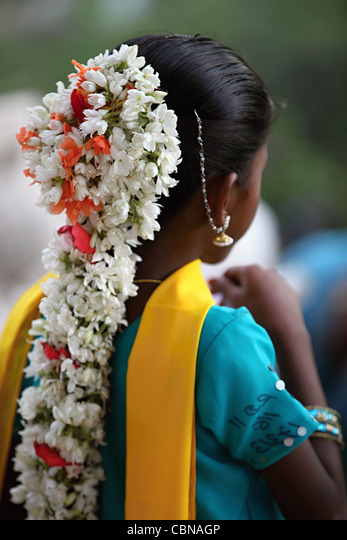
Normally you can wear any type of jasmine, but the common subtypes in Tamil Nadu are ஜாதிமல்லி (jathimalli; "Spanish jasmine"; left) and மல்லிப்பூ (mallipoo; right).


Eating food from a plate made from a banana leaf is more than just an aesthetic, and is often reserved for certain occasions; other times we eat from metal or ceramic plates. I can't vouch for other areas of India but I've been told the reason why banana leaves are predominantly used for large gatherings is because they can signal to diners if the food is rotten or has been poisoned; supposedly the leaf itself starts rotting and releases liquid, but I personally have never seen this happen. But of course, there are also other reasons as to why banana leaves are used (all of which are valid) ranging from being an eco-friendly disposable plate, offloading nutrients into food, or even to make the food taste better. Pick whichever reason you like.
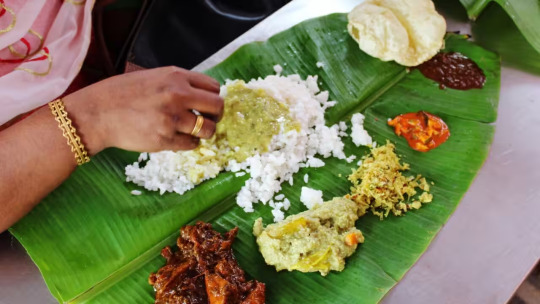
I'm literally so hungry looking at this. (Realises this is a Pavitr thing to say.) Anyway.
FOOD RECS!!!!!!
Reblog with your favourite foods >:) The list will be routinely updated...
JAGGERY COFFEE (from me) - GOOD FUCKING STUFF. ACTUALLY. if you see it.. GET IT IMMEDIATELY
PANI PURI (from @esrev-redips) - #also you forgot to mention the PANI PURI STANDS AHHHHHH YUMYUMYUM | RRRR YOU'RE SO RIGHT. PANI PURI FOR LIFE ACTUALLY.
JASUBEN PIZZA (from @the-witch-forever-lives) - okay this is specific to Ahmedabad | okay but as specific as it may be that sounds and looks delicious??? hello??????
DABELI (from @the-witch-forever-lives) - this too???? also it LOOKS wonderful i need it right now actually
VADA PAV (from @the-witch-forever-lives) - Also Vada pav from Mumbai is so one of a kind | you are absolutely correct. vada pav is truly something magnificent
I think that's about all I can give you right now. This took me a while to type out. Feel free to ask any questions, or if you have anything you would like to add on, like anything I might have glossed over or your favourite desi foods, please do!!! I'll be sure to reblog your addition and update the original post.
The point is that this post can become one of those few other reference posts that artists and writers and other creatives can use if they ever want to make anything related to India, because it's genuinely so cool to see your culture represented so well in popular modern media.
(And in fanfic and fandom. Especially in fanfic and fandom. you have no idea how many times I've gone insane reading a Pavitr-centric fic or reading comments on Pavitr-related posts and it's just outdated ideas and harmful stereotypes and all sorts of sick bullshit, and it's always to the point where I physically have to go outside and bite into a fresh rhizome in order to ground myself. Like damn, people, you need to know things before you start creating)
So uh, I hope this was helpful if not interesting! Happy early Diwali everyone! Knowledge-over-ignorance and all that; hopefully this post does that notion justice!
#pavitr prabhakar#wrote this solely because i wanted more atsv pavitr-centric fics and i need to get that specific immersed-in-india itch scratched#and also because the india i remembered decades ago is definitely not the india i visited last week#wow time flies doesn't it#spider man india#india#writing tips#o wise writer stuff#indian culture#south asian culture#spider man across the spider verse#atsv#across the spider verse#chaipunk#goldenpunk#cultural references#atsv pavitr#agnirambles
211 notes
·
View notes
Text
marauders aesthetic: dark academia
sirius: chin length silky hair in a shag cut. fingers stained with motor oil and black ink. drives everyone crazy with the bold black eyeliner he gets marlene to teach him. twirls his wand and quills between his fingers. old leather jackets thrown over messily buttoned shirts. tie hanging untied around his neck. reads any book he can get his hands on. always has a peppermint on his person. if you're close enough to get a sniff, he smells of damp grass, leather, parchment and mint. chess comes as easy as breathing to him. can't sleep at night, so he climbs out the window and sits on the top of gryffindor tower to stare at the stars. french is his first language, and he speaks italian, greek and latin. only has to study occasionally for herbology. a properly made macchiato, always. half smirks and cocky grins, and grey eyes that spark with mischief. cruel streak a mile wide, so he hates getting angry. a little bit of a slob (it drives james mad). won the under 19 europe duelling tournament at age fourteen. god tier poker face. climbs into james' bed after particularly terrifying nightmares. hums french songs to him to calm himself down. david bowie, led zeppelin, ac/dc, sex pistols. immense raw power that sizzles under his skin and smells like lightning storms. his magic is visible in his veins when he gets emotional. silver eyes, sharp glare, wicked words, even crueler spells. mastermind behind more than half of their pranks. when he laughs, he sounds like the pureblood he is; all refined and perfect. at six feet four inches, he's the tallest of the marauders. loves giving james shit for being shorter than him. plays the violin, and composes sometimes. it reminds him of the nights he locked himself and regulus into the music room at home and played till his fingers bled. perfect waltz, perfect posture, perfect table manners and perfect posh accent.
.
remus: curly golden brown hair in messy undercuts, lanky body and lean muscles. five foot nine inches and hates it. leaves when a person lights up a cigarette; says the smell is overwhelming on his senses. always has a cup of black coffee with him, but never drinks it. comfy jumpers, pressed trousers, perfect uniform, prefect badge pinned to the front. piercings— tongue, ears, nose and lip. charms the tongue piercing to taste like chocolate. hates reading, but does read a few of the books that james recommends. will never give up a chance to sleep in. polite smiles and genial nods in the presence of teachers, quirked eyebrows and infuriating smirks otherwise— he's a two faced little bitch and he's proud of it. doesn't get angry, but does get annoyed. hates confrontation, and will get out of one as fast as possible. sharp wit, sharper tongue. dry, sarcastic remarks under his breath that make peter cry with laughter. a human heater. fingers stained with blue ink and chocolate smudges. if he's not with the marauders, he's either sleeping or studying in the library. best at defence against the dark arts, but still not as good as sirius and james. speaks welsh, scots gaelic and old english. learns french and latin from sirius. a complete, utter mess; everything from his school satchel to his wardrobe to his bed is chaos (james despairs over his habits). absolutely loathes history of magic and potions. favourite subject is care of magical creatures, mostly due to the chaos that professor kettleburn causes. elton john, cher, tchaïkovsky. cannot play any musical instrument, but loves it when sirius and james duet together. smells like chocolate, cinnamon, and honey. owns a diary, and gets called a girl for it by peter. has chronic joint pain that is aggravated by the scotland weather. difficult relationships with his parents, but he still loves them and they love him back.
.
james: messy curls long enough to be tucked behind his ears. the only one who can beat sirius at chess. had an indian accent the first three years of hogwarts. plays the piano to calm himself. six foot one inch and hates it because sirius keeps giving him shit. fingers stained with charcoal, graphite, and alta dye applied for bharatanatyam. always moving, can never sit still unless he's reading or sketching. kajal lining brown eyes and dotted behind his ear for good luck. bright smiles and fondly exasperated shakes of his head. mother hen because "none of these idiots can be trusted to look after themselves". brown skin that just gets darker from quidditch practice in the sun. reads literally anything he can get his hands on, genre does not matter. dozens of journals filled with detailed sketches of anything and everything that catches his eye (a couple of journals are dedicated solely to green eyes. a couple more are filled with sketches of sirius). outstanding at transfiguration and arithmancy. never has to study (it drives peter to apoplexy). does not get offended or angered easily, but will go off on anyone who insults his friends. fits into any clique— jock, nerd, theatre kid, musicians, you name it. hopeless romantic. hates messes, always nagging his friends to clean up after themselves. chai, always. unapologetic mama's boy. proud of his indian lineage. rises before the sun does. always has cold fingers, and steals sirius' jackets. burrows into sirius' hugs for warmth. long, scalding hot baths. mother tongue is marathi. speaks hindi, urdu, french, latin, tamil, greek and sanskrit. loves every subject except history of magic. listens to any genre of music as long as it sounds good. loves balls and galas because he gets to dress up and dance. always has some sort of indian confectionary on him— barfi, laddoo, maisurpak, gulab jamun. it adds a sugary layer to his chandan perfume.
.
peter: buzz cut, but wants to grow it out. steals james' books and never reads them. smells of earth and a woody perfume his mother got for him in fourth year. can't play chess for shit, but is better than remus at gobstones. his bed and closet are well maintained and always neat. laughs a lot (it sounds squeaky), and his eyes twinkle when he smiles. best at herbology and care or magical creatures, but he hates the latter. a sarcastic twerp and a sneaky little shit. has the normal sense of humour— the other three boys thrive off of dark jokes. absolutely loathes studying, but needs to do it, so he does (while grumbling good naturedly about sirius and james not needing to). whistles when he walks the corridors of hogwarts, with his hands in his pockets. loves the waltz, and always has a record playing at low volume whenever possible. atrocious sense of style/fashion, and gets heckled by sirius and james for it. has notebooks upon notebooks filled with little doodles that are surprisingly good. always listens when sirius or james play the violin or piano, and sometimes drags remus into a waltz to make everyone laugh. claims to be annoyed by james' mother henning, but everyone knows he adores it. friends with a lot of the younger students, and always has liquorice or lozenges on him to give to them. cat person, terrified of mcgonagall. he loves watching james perform bharatanatyam, and asked for lessons in fourth year. he gave up within a month, saying he would stick to waltzing, thank you very much. always, always, has a granola bar filled with nuts somewhere in his pockets. does not understand why mint chocolate is a thing, and absolutely refuses to eat anything that has mint in it. steals james' confectionary and gets tackled for it. will eat ice-cream no matter the season, even if he has a cold.
#amrut writes#sirius black#james potter#remus lupin#peter pettigrew#the marauders#marauders#marauders aesthetic#sirius black aesthetic#james potter aesthetic#remus lupin aesthetic#peter pettigrew aesthetic#dark academia#dark academia aesthetic#academia#harry potter#harry potter aesthetic#indian james potter#desi james potter
239 notes
·
View notes